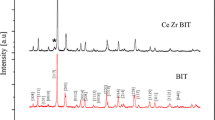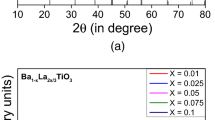Abstract
Barium titanate, which is applied in many fields, is a kind of very important ferroelectric material because it is lead free. Its physical properties are changed by replacement or addition of other ions. Here, barium calcium titanate ((Ba,Ca)TiO3) ceramics are prepared. The concentration of calcium is up to 20 at.%. The Fourier transformation infrared spectroscopy (FTIR) measurement is carried out in order to reveal the vibration of crystal lattices. The influence of the replacement on the interaction between Ti and O can be observed by investigating the absorption peak of the Ti–O bond. The wavenumber of absorption peak of Ti–O bond becomes larger with increase of the content of Ca, even though the concentration of Ti is not changed. The wavenumber of absorption peak in (Ba0.95Ca0.05)TiO3 is near 525 cm−1 while that in (Ba0.80Ca0.20)TiO3 is near 550 cm–1. It is attributed to the decrease of the cell size. The length of Ti–O bond is shortened by replacement of Ca. Then the interaction between Ti and O is enhanced. The similar phenomenon is observed in (Ba,Mg)TiO3 and alkali doped BaTiO3 materials as well, supporting the mechanism. Furthermore, the aging effect in (Ba,Ca)TiO3 and (Ba,Mg)TiO3 systems is observed. The former exhibits a good stability when the latter shows unstable FTIR spectra. The influence of point defects on the aging effect is discussed. These results indicate that the FTIR measurement is helpful to study the relationship between the structure and physical properties of ferroelectric materials.











Similar content being viewed by others
References
K. Uchino, Ferroelectric Device (Dekker, New York, 2000), pp. 1–9
L.E. Cross, Ferroelectrics 151, 305 (1994)
D. Sun, M. Zhao, H. Luo, Z. Yin, J. Inorg. Mater. 15, 939 (2000)
D. Sun, X. Ren, K. Ostuka, Appl. Phys. Lett. 87, 142903 (2005)
Y. Xu, Ferroelectric Materials and Their Applications (Elsevier Science Publisher B. V., Amsterdam, 1991), pp. 129–142
B. Noheda, N. Duan, N. Cereceda, J.A. Gonzalo, J. Korean Phys. Soc. 32, S256 (1998)
D. Sun, S. Lin, J. Korean Phys. Soc. 32, S205 (1998)
P. Qiu, W. Luo, A. Ding, J. Inorg. Mater. 16, 928 (2001)
R.B. Atkin, R.M. Fulrath, J. Am. Ceram. Soc. 54, 313 (1971)
P. Qiu, A. Ding, X. He, W. Luo, Proc SPIE 4086, 692 (2000)
K. Babooram, Z.G. Ye, Chem. Mater. 16, 5365 (2004)
F.X. Perrin, V. Nguyen, J.L. Vernet, J. Sol–Gel Sci. Tech. 28, 205 (2003)
R. Asiaie, W. Zhu, S.A. Akbar, P.K. Dutta, Chem. Mater. 8, 226 (1996)
K. Nomura, Z. Homonnay, G. Juhasz, A. Vertes, H. Donen, T. Sawada, Hyperfine Interact 139, 297 (2002)
S.K. Lee, S.S. Ryu, D.H. Yoon, J. Electroceram. 18, 1 (2007)
C.H. Perry, B.N. Khanna, Phys. Rev. 105, A408 (1957)
J.T. Last, Phys. Rev. 105, 1740 (1957)
JCPDS Powder Diffraction File Card No. 05–526, International Centre for Diffraction Data, Newtome Square, PA, 1967
Acknowledgement
The authors would like to thank Shanghai Shuguang project (04SG48), Shanghai Leading Academic Discipline project (T0402), Shanghai Education Committee project (07ZZ66), and Shanghai Pujiang project (05PJ14082) for supporting the research.
Author information
Authors and Affiliations
Corresponding author
Rights and permissions
About this article
Cite this article
Jin, X., Sun, D., Zhang, M. et al. Investigation on FTIR spectra of barium calcium titanate ceramics. J Electroceram 22, 285–290 (2009). https://doi.org/10.1007/s10832-007-9402-1
Received:
Accepted:
Published:
Issue Date:
DOI: https://doi.org/10.1007/s10832-007-9402-1




